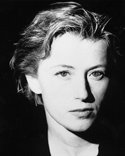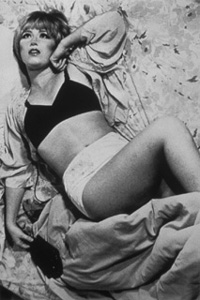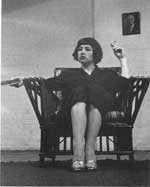
¡@
Links:





 ¡@
¡@
 Cindy
Sherman
Cindy
Sherman
By turning the camera on herself, Cindy Sherman has built a name as one of the most respected photographers of the late twentieth century. Although, the majority of her photographs are pictures of her, however, these photographs are most definitely not self-portraits. Rather, Sherman uses herself as a vehicle for commentary on a variety of issues of the modern world: the role and representation of women in society, the media and the nature of the creation of art.
The youngest of five children, Sherman was born in 1954, in Glen Ridge, New Jersey, a suburb of New York City. Her family moved shortly after her birth to Huntington, a suburban Long Island, were she was raised. Unlike some budding artists, Sherman was not particularly involved in the arts as a young person. Her father made a living as an engineer and her mother worked as a reading teacher. Sherman had said that, ¡§It wasn't until college that I had any concept of what was going on in the art world. My idea of being an artist as a kid was a courtroom artist or one of those boardwalk artists who do caricatures. My parents had a book of, like, the one hundred one beautiful paintings, which included Dali and Picasso among the most recent artists." Despite her parents lack of artistic interest, they were supportive of her choice to enter art school after finishing high school, though, according to Sherman, her mother did caution her to "take a few teaching courses just in case."
Her exploration of art began at the State University of New York at Buffalo. She enrolled in the basic studio course - drawing, painting, and photography - and promptly failed photography. The difficulties of technical photography stumped her and she had no interest in the subtleties in making "perfect" prints. The photography fallout led Sherman to focus on her major: painting. Sherman painted realistically from magazine and photographic cut outs. She had particularly adept at copying things as exactly as possible, and even did self-portraits from a mirror. Frustrated with the limitations of painting and feeling like she had done all that she could, she gave it up. Sherman had said that she felt that " . . .There was nothing more to say [through painting]. I was meticulously copying other art and then I realized I could just use a camera and put my time into an idea instead.¡¨ in an interview with Noriko Fuku.
Looking elsewhere for inspiration, Sherman finds herself drawn to the theatricality offered by performing arts, new music and films. This is reminiscent on Sherman's childhood activities, where she engages in games of make - believe. Keeping a trunk filled with clothes that she used when playing dress ups, she and her friends transform themselves into characters, like and old women or a monster. She invented characters and places them together in various forms of masquerade. " I'd dress up like an old woman and walk around, fooling with neighbours." As an art student in Buffalo, she became notorious for going out in public dressed as Lucillie Ball or as a pregnant woman in galleries. Although with the newfound source of inspiration, Sherman still had to get past the introductory photography course requirement. On her second attempt, she had a different experience. Rather than having to struggle with issues of technique and with someone else's idea of quality, her new teacher, Barbara Jo Revelle, stressed the ideas and concepts that made a good photograph. Revelle inspired Sherman to "just take pictures". Using Conceptual Art as a guide and following her own interests, the replication - obsessed Sherman discovered after all that, she does indeed like the immediacy of photography. Snapping away with a camera is a lot more direct and rewarding than trying to paint exact copies of things. In retrospect, Sherman had expressed that she never could have succeeded as a painter, stating that she is unable to react to painting in anything more than a visceral way. Lacking the critical connection needing to proceed with painting, Sherman turned to photography, which she studied for the remainder of her time at Buffalo.
The year 1974 was a turning point for Sherman. Having found her niche in photography, she was ready to get serious about making art. Near the end of the sophomore year, she meets a painting student named Robert Longo and become an item. Together with Longo and fellow students Charles Clough, Nancy Dwyer, Michael Zwack, and some other artist, Sherman formed Hallwalls, an independent artists' space where she and fellow artists exhibited. Unveiling at an opportune moment, Hallwalls quickly become a vital and influential centre. Clough and Longo's determination for success helped raised money, which attracted unprecedented number of important artist, filmmakers and critics to Buffalo. This including Helene Winer, the director of Artists Space, an influential alternative space in Manhattan, who invited the Hallwalls group to produce an exhibition of their work in Artists Space.
Inspired by Longo, Sherman began her own crash course in contemporary art by pouring through all the contemporary art magazines; staging performances with artist friends; watching experimental, foreign and classic movies; and hanging out with her artist friends, who debated ways of making art and who brainstormed about ways of breaking into the art world. In 1975, encouraged by her character experiments and challenged by Longo's suggestion that she recorded her labour-intensive creation, Sherman makes a series of headshots featuring different characters, ranging from a dopey mono-brow guy in a locomotive hat to a fresh- faced young girl with barrettes. This artwork then begins to develop the stylistic characteristics of Sherman's work. Her works contain elements of:
- Performance (Cindy adopts a persona)
- Narrative (the layout creates a change in time)
- Theatre (the adaptation of the character is disarmingly complete)
Sherman¡¦s work is herald as the quintessential post-modern artwork. Nadine Lemmon's article The Sherman Phenomena quotes "... her works can be read as both a challenge to the art world and a creative marketable product" While critics appaud Sherman's work for "deconstructive denying the totality of a 'real Cindy'", the meaning of her work is dependant upon the celebrity 'Cindy'.
After Sherman's 1976 graduation, she decided to move to New York City to embark upon her career in art. Taking a loft on Fulton Street in lower Manhattan, Sherman had begun taking photographs of herself. These photographs would come to be known as the ¡¥Untitled Film Stills¡¦, perhaps the most well-known and recognizable work of Sherman's career thus far. In these photographs, begun in 1977, Sherman places herself in the roles of B-movie actresses. Her photographs show her dressed up in wigs, hats, dresses, clothes unlike her own, playing the roles of characters. While many may mistake these photographs for self-portraits, these photographs only play with elements of self-portraiture and are something quite different. In each of these photographs, Sherman played on a type - not an actual person, but a self-fabricated fictional one. There is the archetypal housewife, the prostitute, the woman in distress, the woman in tears, the dancer, the actress, and the malleable, chameleon-like Sherman, she played all of these characters. For a work of art to be considered a portrait, the artist must have indented to portray a specific, actual person. This can be communicated through such techniques as naming a specific person in the title of the work or creating an image in which the physical likeness leads to an emotional individuality unique to a specific person. While these criteria are not the only ways of connoting a portrait, they are just two examples of how Sherman carefully communicated to the viewer that these works are not meant to depict Cindy Sherman the person. By titling each of the photographs "Untitled", as well as numbering them, Sherman depersonalised the images.
Untitled Film Still, #58
 Untitled
Film Still #10,1978
Untitled
Film Still #10,1978  Untitled
Film Still #6, 1977
Untitled
Film Still #6, 1977
There are also very few clues as to Sherman's personality in the photographs, each one is so unique and ambiguous that the viewer is left with more confusion than clarity over Sherman's true nature. Sherman completed the project three years later, in 1980, when she "ran out of clichés" with which to work. This series gave Sherman much publicity and critical acclaim; she had her first solo show at the non-profited space, The Kitchen, in New York City. In 1980 Sherman also created a series of what she called ¡¥Rear-Screen Projections¡¦ in which, similarly to the ¡§Film Stills¡¨, Sherman dressed up and paraded against a projected slide background.
Film Still #153
In 1981 Sherman was commissioned by the respected magazine Artforum to do a "centrefold" for one of their upcoming issues. Sherman proceeded to submit a series of images with a cohesive aesthetic look: the camera was placed above Sherman, who was often crouched on the ground or made to look like she was in a state of reverie. Artforum¡¦s editor, Ingrid Sischy, who claimed that these photographs ¡§might be misunderstood¡¨, rejected this series, as well as an additional series of Sherman in a pink robe.
Sherman went on and changed her style almost entirely in what are often referred to as the ¡§Disasters and Fairy Tales series¡¨. For the first time in her public career, Sherman was not the model in all of the images. Shot from 1985 until 1989, these images are far more grotesque than Sherman's earlier work. Often intentionally dressing to look scary and deformed, Sherman sets herself in strange, indefinable settings, which often feature oddly, coloured lighting in shades of blue, green and red. At times, Sherman employed dolls parts or prosthetic body parts to substitute for her own and many a scene where strewn with vomit, mould and other vile substances. Sherman's intent was to explore the disgusting, yet these are things that she admittedly can find beauty in.
Sherman's second most known body of work came some time after the ¡¥Film Stills¡¦ had already been well received, around 1988-1990. In the ¡¥History Portraits¡¦ Sherman again uses herself as model, though this time she cased herself in roles from archetypal famous paintings. While very few specific paintings are actually referenced, the audience still feels a familiarity of form between Sherman's work and works by great masters. Using prosthetic body parts to augment her own body, Sherman recreated great pieces of art and thus manipulated her role as a contemporary artist working in the twentieth-century. Sherman lived abroad during this time in her life, and even though museums would appear to be the source of inspiration for this series, she is not a fan of museums: "Even when I was doing those history pictures, I was living in Rome but never went to the churches and museums there. I worked out of books, with reproductions. It's an aspect of photograph I appreciate, conceptually: the idea that images can be reproduced and seen anytime, anywhere, by anyone."
In 1992, Sherman embarked on a series of photographs now referred to as ¡¥Sex Pictures¡¦. For the first time, Sherman was entirely absent from these photographs. Instead, she again used dolls and prosthetic body parts, this time posed in highly sexual poses. Prosthetic genitalia - both male and female - are used often and photographed in extreme close-up. Photographed exclusively in colour, these photographs were meant to shock. Sherman continued to work on these photographs for some time and continued to experiment with the use of dolls and other replacements for what had previously been herself.
Sherman's life and work has been populated by more than just conceptual photography. She has been married to video artist Michel Auder for over 16 years and has found time in her busy career to add work in motion pictures. In 1997, Sherman's directorial debut, ¡¥Office Killer¡¦, starring Jeanne Tripplehorn, was released in theatres. A self-proclaimed lover of horror films, Sherman draws on the characteristics of this genre as well as the visual motifs established as a still photographer. Sherman also made an appearance in front of the camera, making a cameo playing herself in John Waters' 1998 comedy Pecker.
Due to Sherman achieving international success at a relatively young age, her work has had a considerable maturation in value over the past decade. In 1999 the average selling price for one of her photographs was $20,000 to $50,000, a large sum for a female photographer. Even more groundbreaking was a 1999 Christie's auction in which one of the photographs from Film Stills sold for a reported $190,000. This bid was perhaps inspired by the Museum of Modern Art's lead: in 1996, they purchased a complete set from ¡¥Film Stills¡¦ for one million dollars. These prices are indicative of Sherman's huge level of success, both critically and financially. Sherman's popularity continues to grow around the world, as she has exhibited countries including Germany, Japan, and France.
Recently, Sherman has returned to using herself as model. At a recent show at her New York gallery, Metro Pictures, Sherman displayed a series of portrait-like images of herself in the guise of women from California. These women are again stereotypes - The Personal Trainer, The Ex-Realtor, The Divorcee, etc. Sherman further manipulates the notion of portraiture through the use of conventional portrait signs including the setting of the figure against a neutral background. Unlike some of her early photographs, these are more straightforward images of created characters, not narrative fragments. Sherman continues these projects in New York City, where she currently lives and works
¡@
Untitled Film Stills # 27, 1978
Photograph 8x10¡¨ (18x 22.5)
¡@
¡@
Cultural Framework
The series ¡¥Untitled Film Stills¡¦ represent
B¡Vmovie actresses and how women are portrayed in the film industry. The race and place, which are dominantly represented, is American society, Hollywood. Women are portrayed as objects of the ¡¥gaze¡¦, weak and submissive or dangerous (the femme fatale i.e. ¡¥Untitled Film Still #16¡¦). This Artwork can be represented as a protest for women who are mistreated in the film industry or just and interpretation of what Sherman sees on the television translated to an artwork. Sherman photographing herself posing as particular women stereotypes, using props (wigs, hats, dresses, and clothes unlike her own) and camera angles to connotate the character she is portrayed in Untitled Film Stills # 27, one of Sherman¡¦s most famous and striking images, the angle and facial expression pose question for the audience. For example, ¡§Is the women being chased by someone?¡¨ or ¡§ Did she commit murder?¡¨ This creates the same sort of suspenseful atmosphere when watching a movie. This photograph conveys that films sometimes represented women as a threat to the peaceful society. This atmosphere reflects upon Sherman¡¦s time watching television and what she sees when the media represents society.
 Untitled Film Still #16
Untitled Film Still #16
¡@